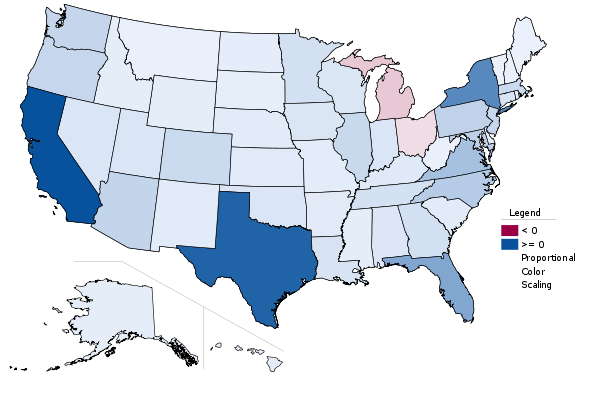Back in June the BEA released preliminary GDP estimates for states. I didn’t get around to looking at it at the time, but this gave us the first chance to take a look at state level GDP performance over the decade of the 2000’s. Here’s a look at total real GDP growth:

It should perhaps be unsurprising that total growth follows population size and population growth. You might think Texas would be #1 given the huge population growth it had, but Texas only came in #2, adding about $233B in GDP (2005 dollars). California actually topped the chart in raw growth, adding $261B. New York, Florida, and Virginia. Michigan and Ohio actually saw a shrinkage in total real GDP.
Of course small states would find it tough to compete on a total measure, so let’s take a look at percentage growth:

Wyoming tops the charts here, growing real GDP by 48.7%, followed closely by resource heavy North Dakota at 47.1%. Oregon, South Dakota, and Alaska top round out the top five. The map makes it obvious that the Midwest is the laggard here, with 7 of the bottom 10 states in percentage real GDP growth are in the Midwest.
I think GDP is a very key statistic since it measures a place’s ability to generate economic value. If you aren’t growing economic output, it’s hard to make progress on most other measures.
Beyond the total measures, per capita GDP is another key statistic. Here’s a map of percentage growth in per capita real GDP over the last decade.

North Dakota and Wyoming flip here, with ND growing by 40.3% and Wyoming by 30.3%. South Dakota, the District of Columbia (reported as if it were a state), and Oregon finish off the top five.
It’s interesting to see here that a place like Texas that added lots of people and GDP, didn’t grow its per capita output all that much – only by 5.6%. Their growth was nearly all of the “horizontal expansion” variety.
Several states also saw their real GDP decline. This includes places traditionally considered successes like Georgia. I’ve noted before the sharp decline in per capita GDP even in Atlanta, the state’s economic engine. A slew of other states were basically flat. Not good for them.

No comments:
Post a Comment